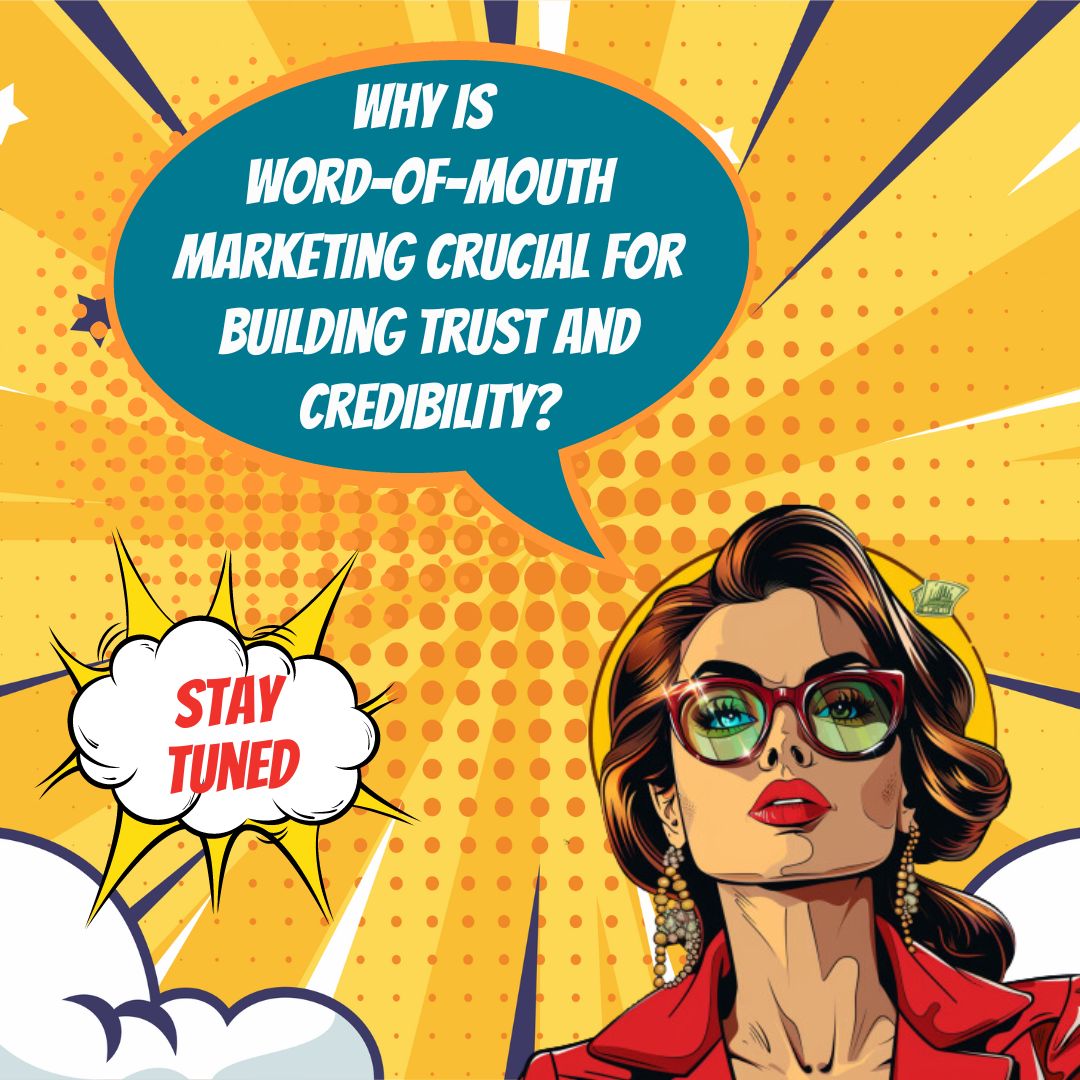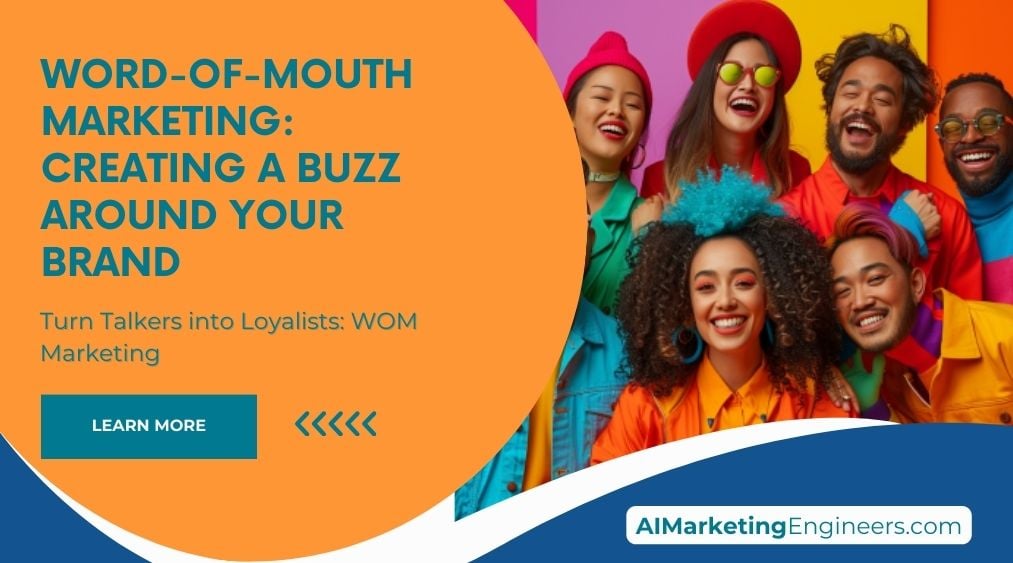Key Takeaways
✅ Deliver Exceptional Customer Experiences: Exceeding customer expectations is paramount. By incorporating personalized touches and being attentive to feedback, businesses can transform satisfied customers into fervent supporters. Remember, a thrilled customer tells their friends, and in today’s word, potentially thousands of social media followers.
✅ Encourage and Incentivize Word-of-Mouth: Offering rewards for referrals can turn your customer base into a motivated sales force. Simple gestures like discounts or loyalty points not only encourage existing customers to spread the word but also draw in new ones, fueling your brand’s growth organically.
✅ Leverage Social Media and Storytelling: Social platforms are modern-day market squares where stories create connections. Sharing engaging, relatable content that highlights your brand’s values can turn passive viewers into active participants and brand advocates, amplifying your reach exponentially.

Introduction
Have you ever wondered why some brands seem to be on everyone's lips? They're mentioned at dinner parties, shared across social channels, and even recommended in casual coffee shop conversations. The secret sauce? Word-of-Mouth Marketing (WOMM). In an age where consumers are bombarded with advertisements, 81% of people trust recommendations from family and friends over business messaging. This stark statistic underlines the immense power of WOMM in creating a genuine buzz around your brand.
Word-of-Mouth Marketing isn't just about creating noise; it's about building deep, trust-based relationships with your customers, turning them into fervent ambassadors for your brand. From incentivizing referrals to leveraging the viral potential of social media, this marketing strategy harnesses the natural desire for people to share their best experiences with others.
But how can you pivot your strategy to not only encourage but also amplify word-of-mouth for your brand? We've dived deep into the modern trends, from engaging storytelling and influential social media campaigns, to innovative referral incentives that promise to maximize your brand's visibility, revenue, and return on ad spend (ROAS). Get ready for actionable insights and groundbreaking information that could redefine the way you think about marketing. Stay tuned.

Top Statistics
| Statistic | Insight |
|---|---|
| Word-of-mouth marketing drives $6 trillion of annual consumer spending. | This massive figure underscores the undeniable power of personal recommendations and the sea of opportunities it presents for brands. |
| 83% of consumers say they trust recommendations from family and friends. | This high level of trust highlights the importance of building an authentic connection with your audience, encouraging them to talk positively about your brand. |
| Referral programs generate good or excellent leads for 78% of business-to-business (B2B) marketers. | Clearly indicates the efficiency and effectiveness of referral programs in generating high-quality leads in the B2B sector. |
| Millennials are influenced by word-of-mouth marketing 115% more than traditional advertising. | This statistic emphasizes the need for brands to leverage word-of-mouth marketing strategies to connect with this demographic effectively. |
| By the end of 2024, the influencer marketing industry is expected to reach an estimated value of over $24 billion. | This forecast demonstrates the growing investment and reliance on influencers as a vital source of word-of-mouth for brands around the globe. |
What is Word-of-Mouth Marketing?
Imagine sitting across from a friend at a coffee shop. They mention a brand they love, and suddenly, you're intrigued. That's word-of-mouth marketing (WOMM) in action. It's simple: people are more likely to trust recommendations from friends and family than any advertisement. In fact, a whopping 81% of consumers trust these personal endorsements over traditional business ads. Why does this matter? Because WOMM taps into this trust, making it a powerful strategy for businesses to spread the word about their products or services.

Types of Word-of-Mouth Marketing
Word-of-mouth marketing isn't just one thing. It's a blend of strategies designed to get people talking about your brand. From publicity efforts that build your brand's presence and reputation, to buzz marketing methods that encourage passionate discussions, each type serves a unique purpose. Viral marketing focuses on content that's so compelling it spreads on its own. Then there's blogging, creating a bond with readers through insightful posts. Emotional marketing aims to stir feelings that motivate people to share, while referral marketing rewards them for doing just that. Lastly, social media marketing uses the power of online platforms to foster digital word-of-mouth.
Creating a Buzz Around Your Brand
Building buzz is about encouraging happy customers to spread the word. Highlighting reviews and ratings works wonders for social proof, proving to potential customers that your offerings are both liked and trusted. Embracing user-generated content, whether it's a photo with your product on Instagram or a customer testimonial video, shows real people enjoying what you sell. Offering incentives and referral programs motivates your customers to become brand ambassadors. And never underestimate the power of storytelling; sharing your brand's journey can cultivate an emotional connection and loyalty among your audience.
Movement Marketing: A New Dimension of Word-of-Mouth
Movement marketing takes WOMM a step further by aligning your brand with a larger cause. It's not just about selling a product; it's about rallying your audience around shared values and goals. Brands like Nike with its Move To Zero initiative and Dove’s Real Beauty campaign have mastered this. They're not just selling athletic wear or beauty products; they're promoting sustainability and challenging beauty norms. Successfully pulling this off requires authenticity, a clear purpose beyond transactions, and ways for people to show their support visibly.

Measuring Success with Word-of-Mouth Marketing
So, how do you know if your word-of-mouth marketing efforts are paying off? It's not just about looking at your sales. Yes, financial metrics like revenue and market share are important, but don't overlook marketing metrics. Monitoring how engaged your customers are, your brand awareness levels, and how many return for another purchase can give you insights into the real impact of your WOMM campaigns. Tracking these metrics will tell you not just if you're reaching your audience, but if you're truly engaging them.
Word-of-mouth marketing stands as a pillar of trust and credibility in a world where consumers are bombarded with ads. By understanding the different types and incorporating strategies like user-generated content, storytelling, and movement marketing, brands can create a lasting and genuine buzz. Beyond crafting messages, it's about inspiring conversations that resonate on a personal level. At its core, successful WOMM is about making your brand something people not only want to talk about, but are proud to recommend.
AI Marketing Engineers Recommendation
Recommendation 1: Leverage Social Proof through Customer Reviews and Testimonials: In today's digital age, consumers value transparency and authenticity. A compelling way to harness Word-of-Mouth Marketing: Creating a Buzz Around Your Brand is by encouraging satisfied customers to share their positive experiences online. According to a BrightLocal study, 87% of consumers read online reviews for local businesses in 2020, an increase from 81% in 2019. This statistic underlines the power of social proof. By showcasing genuine customer reviews and testimonials on your website and social media channels, you can significantly boost credibility and attract new customers.
Recommendation 2: Create Shareable Content that Resonates with Your Audience: In the context of Word-of-Mouth Marketing, creating content that is engaging, useful, and shareable is key to making your brand buzzworthy. This could be anything from an insightful blog post, a captivating video, to an informative infographic. The goal is to provide value in a way that compels your audience to share with their networks. Current trends show that video content, for example, is not only more engaging but also more likely to be shared. A study by Wyzowl indicates that 84% of people say they’ve been convinced to buy a product or service by watching a brand’s video.
Recommendation 3: Encourage User-Generated Content (UGC) to Foster Community and Trust. UGC, such as photos, videos, or reviews submitted by customers, embodies the essence of Word-of-Mouth Marketing by allowing users to tell your brand's story. This not only helps in creating a lively community around your brand but also significantly increases trust among prospective customers. Moreover, featuring UGC can lead to a direct increase in engagement and conversion rates. According to a report by TINT, 92% of consumers trust organic, user-generated content more than they trust traditional advertising. By encouraging and facilitating UGC, brands can amplify their word-of-mouth reach while building a stronger, more authentic relationship with their audience.

Relevant Links
- Exploring the Psychology Behind Word-of-Mouth Marketing
- The Evolution of Word-of-Mouth Marketing in the Digital Era
- Maximizing WOMM Strategies with Data-Driven Insights
- Unlocking the Potential of Social Media in WOMM
- Case Studies: Successful Word-of-Mouth Marketing Campaigns
Conclusion
In the bustling marketplace of today, word-of-mouth marketing (WOMM) stands out as a beacon of trust and authenticity, far outstripping traditional advertising methods in creating deep, lasting connections between brands and their audiences. At its core, WOMM empowers everyday conversations to become the lifeblood of brand growth and reputation. With 81% of consumers placing more trust in recommendations from friends and family than any business message, the significance of WOMM is unmistakable.
This journey through the realms of WOMM, from its definition and importance to the innovative strategies that fuel its success, underscores the pivotal role of personal endorsement in today’s digital age. From buzz marketing to movement marketing, the tactics are as varied as they are effective, each playing a unique role in weaving a brand into the fabric of everyday conversations. Encouraging customer reviews, leveraging user-generated content, and harnessing the power of compelling stories are more than just strategies; they are the cornerstones of building a brand that resonates and endures.
In moving forward, it's clear that the brands which embrace the values of authenticity, transparency, and genuine customer engagement are the ones that will thrive. By aligning with customers not just as consumers, but as part of a larger, shared mission, businesses can ignite passions and inspire a level of brand advocacy that advertising dollars simply can't buy.
As we close this exploration of word-of-mouth marketing, let's consider it not as an endpoint, but as an invitation to innovate and inspire. Whether through the creation of buzz, the sharing of impactful stories, or the cultivation of movements that matter, the potential for brands to connect and grow in meaningful ways is limitless. The question now is, how will your brand harness the power of WOMM to create a lasting buzz in an ever-changing world?

FAQs
Question 1: What is Word-of-Mouth Marketing?
Answer: Word-of-Mouth Marketing (WOMM) is a strategy that encourages satisfied customers to share their positive experiences with others, generating buzz and driving brand awareness.
Question 2: Why is Word-of-Mouth Marketing Important?
Answer: WOMM is crucial because it builds trust, increases brand credibility, and drives sales through personal recommendations.
Question 3: What are the Key Elements of Word-of-Mouth Marketing?
Answer: Key elements include creating exceptional customer experiences, fostering engagement, and incentivizing customers to share their experiences.
Question 4: How Does Word-of-Mouth Marketing Impact Customer Acquisition?
Answer: WOMM significantly influences customer acquisition as it increases the likelihood of new customers trying a product or service based on recommendations from trusted sources.
Question 5: What Role Does Social Media Play in Word-of-Mouth Marketing?
Answer: Social media amplifies WOMM by providing platforms for customers to share their experiences, allowing brands to engage with customers, and facilitating the spread of positive word-of-mouth.
Question 6: How Can Brands Measure the Effectiveness of Word-of-Mouth Marketing?
Answer: Brands can measure WOMM effectiveness through metrics such as customer retention, referral rates, and Net Promoter Score (NPS).
Question 7: How Can Brands Encourage Word-of-Mouth Marketing?
Answer: Brands can encourage WOMM by providing exceptional customer service, offering incentives for referrals, and creating engaging content that sparks conversations.
Question 8: What are Some Effective Word-of-Mouth Marketing Strategies?
Answer: Effective strategies include influencer partnerships, user-generated content campaigns, and loyalty programs that reward customer advocacy.
Question 9: How Can Brands Handle Negative Word-of-Mouth?
Answer: Brands should handle negative WOMM by promptly addressing customer concerns, apologizing for any issues, and using the feedback to improve their products or services.

Academic References
- Sweeney, J. C. (2018). Word-of-mouth marketing. In E. L. MacGeorge & L. M. Van Swol (Eds.), The Oxford handbook of advice. This chapter provides a comprehensive overview of word-of-mouth marketing, highlighting its significance and various aspects of the concept. Understanding the mechanics behind word-of-mouth can aid marketers in leveraging this tool more effectively within their strategies.
- Ishii, R. and Kikumori, M. (2023). "Word-of-mouth in business-to-business marketing: a systematic review and future research directions". Journal of Business & Industrial Marketing, Vol. 38 No. 13, pp. 45-62. This systematic review analyzes the current state of word-of-mouth research in the business-to-business context, identifying key themes and future research directions. It highlights how word-of-mouth differs in B2B settings compared to consumer markets, offering insights into tailored strategies.
- Barreto, A. M. (2014). Word-of-mouth marketing: A review of the literature. Journal of Marketing and Management, 29(1), 1-25. This review provides an in-depth examination of word-of-mouth marketing, covering its definition, types, and impact on consumer behavior. It offers valuable insights into how word-of-mouth influences purchasing decisions and spreads within consumer communities.
- Aarikka-Stenroos, L., & Makkonen, S. (2014). Word-of-mouth and its impact on business-to-business sales. Journal of Business-to-Business Marketing, 21(1), 1-23. This study explores the role of word-of-mouth in business-to-business sales, highlighting its influence on purchasing decisions and customer relationships. The findings suggest that in the B2B sector, word-of-mouth can significantly shape sales outcomes and business relationships.






